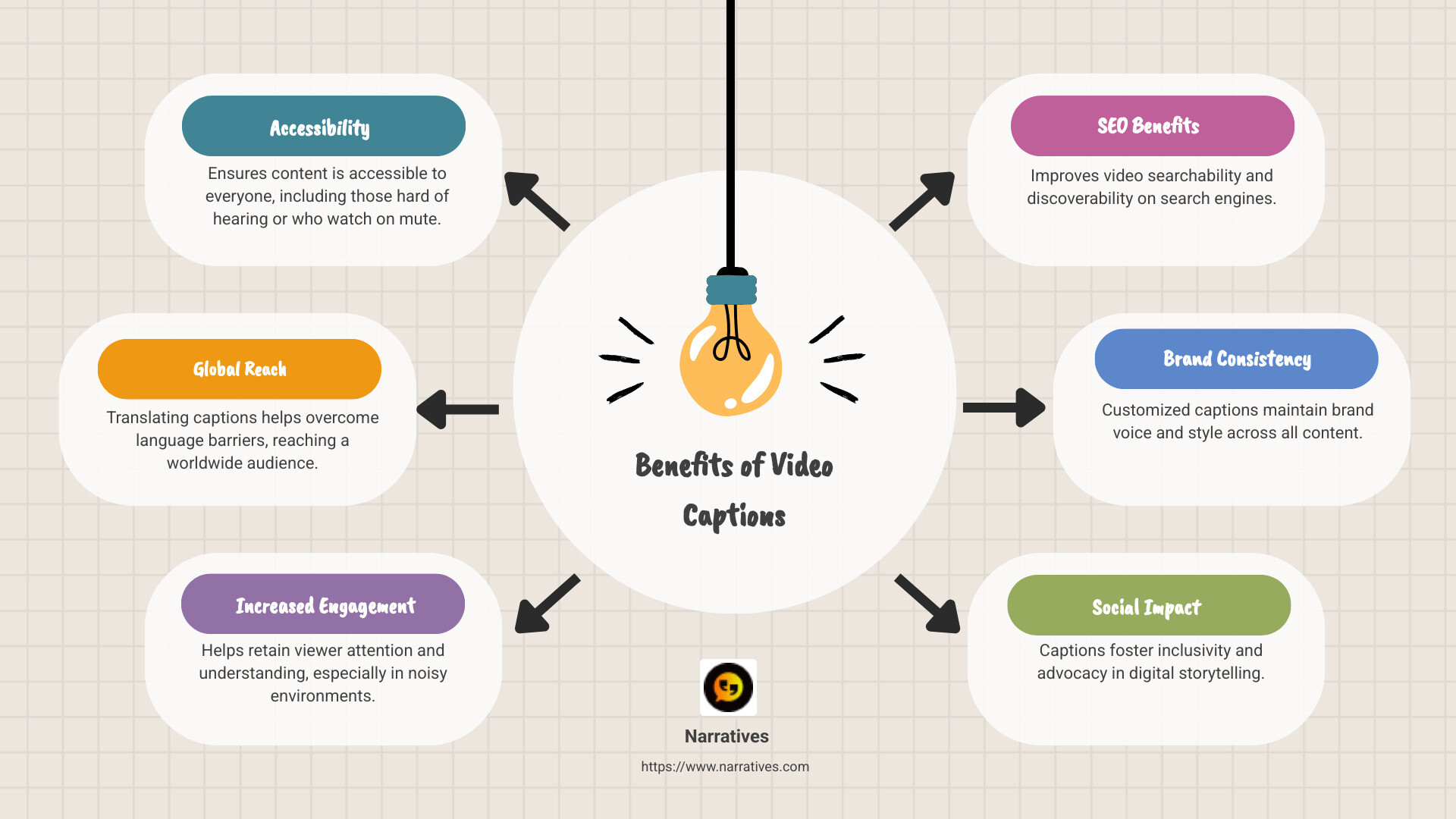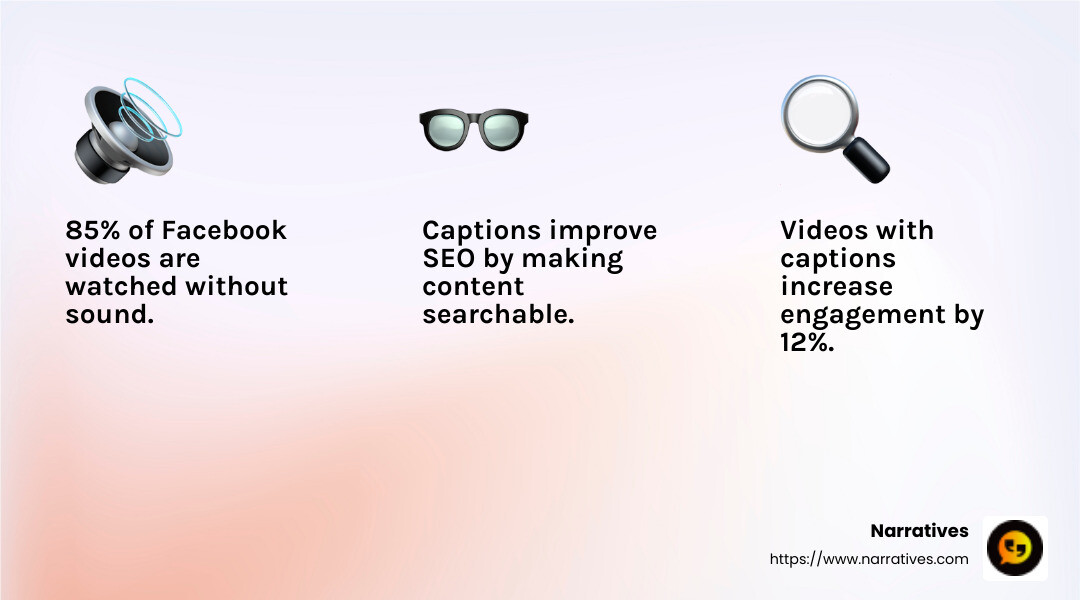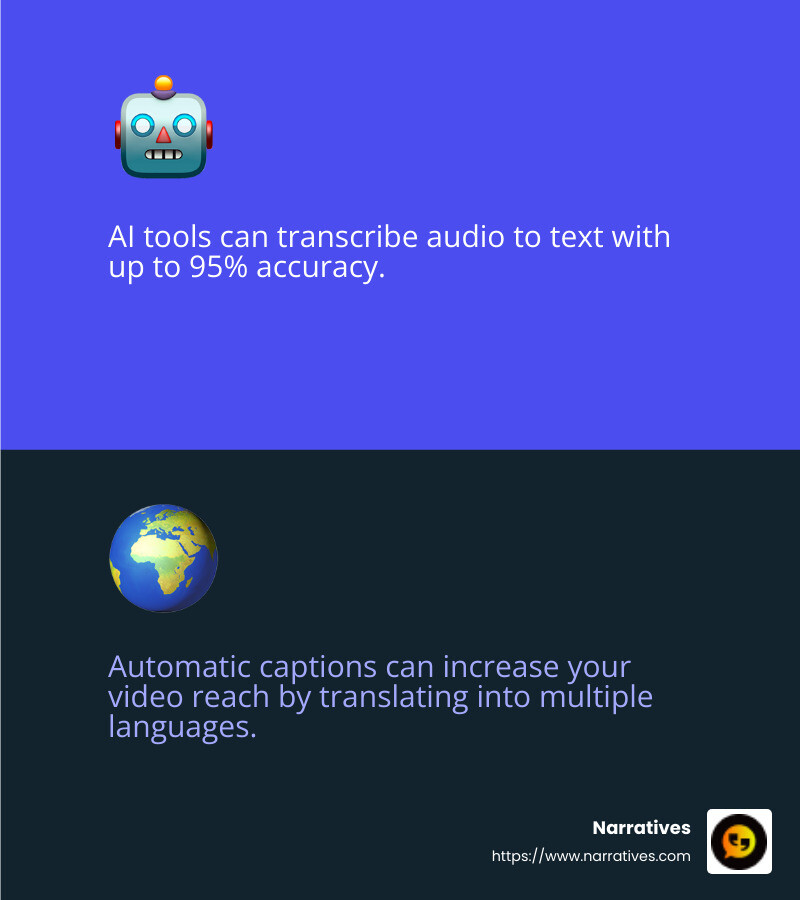Speak Up: Making Videos Accessible with Captions

Make captions for video are vital in today's digital storytelling landscape. They bridge accessibility gaps and enrich content, changing videos into inclusive experiences. For content creators and organizations focused on advocacy and social impact, featured captions are more than just an add-on—they're a necessity.
Adding captions helps:
Improve accessibility: Captions ensure that your message reaches everyone, including those who are hard of hearing or prefer watching videos on mute.
Reach a wider audience: By translating your captions into multiple languages, you can communicate effectively across borders, connecting with a global audience.
Boost engagement: Well-placed captions can increase viewer retention by making content easier to follow, especially in noisy environments or on social media platforms where videos auto-play without sound.
Incorporating video captions into your content strategy is a step towards greater inclusivity and connection.

Make captions for video terms to know:
The Importance of Captions in Video Content
Captions aren't just a nice-to-have feature; they're essential for making video content truly accessible and engaging. Let's break down why captions are so important.
Accessibility
Captions bridge the accessibility gap. They allow everyone, including those who are deaf or hard of hearing, to enjoy video content. But it's not just about hearing impairments. Many people watch videos in environments where sound isn't an option, like noisy public spaces or quiet libraries. Captions ensure they don't miss out.
Consider this: Captions can also help non-native speakers understand your content better. By offering translations, you make it possible for people around the world to connect with your message.
Engagement
Captions boost engagement. Videos on social media platforms often autoplay without sound. Captions grab attention and help viewers follow along, increasing watch time. When viewers can read along, they're more likely to continue watching.
In fact, videos with captions have shown to have higher retention rates. People stay engaged longer because captions help them understand and absorb the content more effectively.
SEO Benefits
Captions can improve your SEO. Search engines can't "watch" videos, but they can read text. By adding captions, you provide a layer of text that search engines can index. This helps categorize your video content, making it more findable.
Moreover, when more people watch your videos, it signals to search engines that your content is engaging and relevant. This can lead to better rankings in search results, increasing your reach even further.

Incorporating captions into your video strategy isn't just about following trends; it's about making your content accessible, engaging, and findable. Whether you're a content creator, educator, or social media manager, captions can help you reach a broader audience and make a bigger impact.
How to Make Captions for Video
Creating captions for your videos is a powerful way to improve accessibility, engagement, and reach. Let's explore two main approaches: using AI tools for automatic captions and employing manual captioning techniques.
Using AI Tools for Automatic Captions
AI-powered tools have revolutionized the way we generate captions. With just a few clicks, these tools can transcribe speech into text, making the process faster and more efficient.
AI Subtitling and Real-Time Transcription
AI subtitling tools like Captions and Kapwing's Translation Studio provide real-time transcription capabilities. They analyze the audio track of your video and automatically convert it into text with impressive accuracy. This is especially useful for live events or webinars where time is of the essence.
These tools also offer the ability to translate subtitles into multiple languages, expanding your content's reach to a global audience. Imagine reaching viewers in different countries without the need for separate videos!

Manual Captioning Techniques
For those who prefer a hands-on approach, manual editing offers more customization options. This method involves creating and editing subtitles to ensure they align perfectly with your video's timing and style.
SRT Files and Customization Options
One common method of manual captioning involves using SRT files. These are plain text files that contain subtitle text and timing information, making them easy to edit and customize. You can adjust the font style, size, and color to match your brand's aesthetics.
Additionally, manual captioning allows you to add audio cues and other contextual information, making the captions more descriptive and informative. This is particularly useful for educational or instructional videos where detail is key.
Whether you choose AI tools or manual techniques, the goal remains the same: to create captions that improve your video's accessibility and engagement. By doing so, you ensure that your content is not only seen but also understood by a diverse audience.
Next, we'll explore how customizing captions can further align them with your brand's identity.
Enhancing Video Accessibility with Captions
Customizing Captions for Brand Consistency
Customizing captions isn't just about making your videos accessible; it's also about maintaining brand consistency. With the right adjustments, captions can reinforce your brand's identity while reaching a global audience.
Language Translation for Global Reach
One of the standout features of modern captioning tools is the ability to translate subtitles into multiple languages. This capability is essential for expanding your content's reach to a global audience. For instance, tools like Captions allow translations in over 40 languages, including Spanish, Chinese, and Arabic. This means your videos can connect with viewers worldwide without needing separate versions for each language.
Font Styles and Color Options
Aligning captions with your brand's visual identity is crucial. Customization options like font styles and colors can help. For example, if your brand uses a specific font or color scheme, you can apply these to your captions. This ensures that your captions are not just functional but also visually cohesive with your overall brand presentation.
Creating a Consistent Brand Experience
Imagine a viewer watching your video on mute in a crowded place. Captions with your brand's unique style can still communicate your message effectively. This visual consistency helps build brand recognition and trust, even when the audio isn't accessible.
By offering language translations and customizing visual elements like fonts and colors, you can make captions for video that are not only accessible but also an integral part of your branding strategy. This approach ensures your content is inclusive and resonates with audiences worldwide, all while keeping your brand front and center.
In the next section, we'll address some frequently asked questions about captions to further clarify their role and benefits in video content.
Frequently Asked Questions about Captions
Can subtitles improve video SEO?
Absolutely! Subtitles can significantly boost your video's SEO. When you add captions to video, you're not just providing text for viewers—you're adding a layer of information that search engines can read and categorize. This helps search engines understand your video's content better, leading to improved rankings in search results.
Think of subtitles as a way to make your video more findable. They widen your audience reach by making your content accessible to non-native speakers and people who are hard of hearing. Plus, when more people watch your videos, it signals to platforms like Google that your content is engaging and valuable, which can further improve your SEO.
Are subtitles and captions the same thing?
While often used interchangeably, subtitles and captions serve different purposes. Subtitles are primarily for translating or transcribing spoken content for viewers who may not understand the original language. They're great for reaching a global audience.
On the other hand, captions are designed for viewers who may be deaf or hard of hearing. Captions include not just dialogue but also audio cues like background noises or music. This ensures a fuller viewing experience by describing all audible elements, making the content more inclusive.
Do subtitles affect video engagement?
Yes, subtitles have a notable impact on video engagement. On platforms like Instagram, TikTok, and YouTube, videos often autoplay without sound. Subtitles grab attention and help viewers follow along without needing audio.
When viewers can read along with the video, they're more likely to stay engaged and continue watching. This leads to higher watch times and better viewer retention. In fact, videos with captions or subtitles often see increased engagement because they cater to diverse viewing preferences, whether someone is in a noisy environment or simply prefers reading along.
By understanding these aspects of captions and subtitles, you can make more informed decisions about incorporating them into your video strategy, ultimately enhancing your content's reach and effectiveness.
Conclusion
As we wrap up our exploration of video captions, it's clear how essential they are in today's digital storytelling landscape. At Narratives, we believe in the power of captions to transform how stories are told and received, especially for non-profits and purpose-driven organizations.
Non-profit storytelling is about more than just sharing information—it's about creating connections and inspiring action. Captions play a crucial role in making these stories accessible to a wider audience, including those who are deaf, hard of hearing, or non-native speakers. By adding captions, we ensure that every voice is heard, and every story is understood.
Moreover, captions help amplify community impact. They make content more inclusive, allowing organizations to reach diverse audiences and engage them more effectively. This is vital for non-profits seeking to build trust and visibility in their communities.
By using captions, we're not just enhancing video accessibility—we're also supporting the missions of those who strive to make the world a better place. At Narratives, we're committed to helping non-profits tell their stories in a way that resonates, inspires, and drives positive change.
For more insights on how we can help your organization lift its storytelling, learn more about our services. Let's use the power of captions to speak up and make every story count.


